Abstract
This article reviews the possibilities to reduce the crude protein concentration in feed for broiler chickens. Considering concentrations of all essential amino acids allows for a reduction of the crude protein concentration in the feed for 1 to 21 days-old broiler chickens to about 19%, without impaired growth. Considering nonessential amino acids only as their sum does not allow for a reduction any further. Instead, single nonessential amino acids need to be considered. The nonessential amino acids glycine and allow for a serine are growthlimiting in feed for broiler chickens containing less than 19% crude protein. Glycine and serine are best assessed together as glycine equivalents (Glyequi) due to the equal effect of these amino acids on the growth. Adequate concentrations of Glyequi allow to reduce the crude protein concentration in the feed for 1 to 21 days-old broiler chickens to about 16% without implications on the growth. The requirement for Glyequi depends on the concentrations of other nutrients in the feed, such as threonine, choline, and cysteine. A reduction of the crude protein concentration below 16% is expected to be possible in the future by optimizing the Glyequi concentration in the feed and the factors influencing the response to Glyequi.
Keywords
broiler chickens, low protein feed, glycine, nonessential amino acidsCo-Author
M. Rodehutscord
Introduction
The increasing demand for meat and other animal products and the concomitant global limitation of arable land results in a shortage of protein-rich feedstuff to be expected. Consequences of increased crop prices have been shown to especially affect the affordability of food in developing countries. Excreted nitrogenous compounds of broiler chickens and other farm animals can have negative effects on the environment, including soil, water and atmosphere. In addition, high ammonia levels in the animal house can affect human and animal health as well as the acceptance of livestock farming by the public due to unpleasant odors. Nitrogen excretion of animals can be reduced effectively by lowering the crude protein concentration in the feed. Experiments, however, showed that feed containing a crude protein concentration of less than 19 to 20% often had undesirable effects on the performance of 1 to 21 days-old broiler chickens even though the requirement of all essential amino acids was met.About ten years ago, several potential reasons for unfavorable effects of low crude protein feed for broiler chickens have been discussed (Aftab et al., 2006). One of those reasons is a potentially different optimal concentration of essential amino acids between standard and low crude protein feed. This aspect was targeted in numerous studies. Some studies supplemented free amino acids to low crude protein feed to raise the level of all essential amino acids above recommendations (e.g. Jiang et al., 2005). This consistently did not overcome the reduced growth induced by low crude protein feed. In other studies, the concentrations of single essential amino acids or combinations of essential amino acid were varied (e.g. Si et al., 2004). This had no effect on the growth in most cases. Few studies reported an increased growth compared to the low crude protein feed. However, the growth of standard crude protein feed has not been met in any of the studies.
The effect of nonspecifc nonessential amino-nitrogen was evaluated by investigating the effects of different combinations or levels of nonessential amino acids in the feed (e.g. Namroud et al., 2010). This had no effect on the growth in some studies. In other studies, a growth-increasing effect compared to the low crude protein feed was reported, but the level of growth of standard crude protein feed has not been achieved. Considering the sum of nonessential amino acids probably is not sufcient because specifc metabolic processes can become limiting. This leads to the implication that single nonessential amino acids are important to avoid unfavorable effects of low crude protein feed on the growth of broiler chickens.
Glycine in the nutrition of broiler chickens
Single nonessential amino acids have been supplemented to low crude protein feed in several studies. Supplementing free glutamic acid, aspartic acid, proline, and alanine consistently did not prevent from reduced growth caused by feeding low crude protein feed (Corzo et al., 2005; Dean et al., 2006). However, growth-increasing effects were determined when free glycine was supplemented. Two studies showed that supplementing feed with a crude protein concentration of 16% with free glycine to the level of about 22% crude protein control feed prevented reduction of growth compared to the control feed (Dean et al., 2006; Awad et al., 2015).However, the concentration of glycine in nutrition of broiler chickens cannot be considered alone because studies revealed that serine in the feed has the same effect on the growth as glycine (Sugahara and Kandatsu, 1976). Animals can convert glycine into serine and vice versa. This interconversion seems to be not limited in poultry. The analogue effect of glycine and serine often is taken into account by calculating the sum of the concentrations of glycine and serine (Gly+Ser). However, this neglects the fact that glycine and serine in the feed are equally effective only when the same molar amount of those amino acids is considered. Therefore, Dean et al. (2006) proposed calculating the glycine equivalent (Glyequi) as the sum of glycine and the molar glycine equivalent of serine, calculated as follows:
Glyequi (g/kg) = glycine (g/kg) + [0.7143 × serine (g/kg)] where 0.7143 is the ratio of the molar weight between glycine and serine. Formulating feed using Glyequi is more appropriate than using Gly+Ser and its calculation is easy. Therefore, using Glyequi is recommended for future industry applications. Once calculated for the feedstuffs, Glyequi can be handled like any other single amino acid in feed formulation.
Glycine and serine are incorporated in almost all body proteins. Collagen and elastin are amongst the proteins richest in glycine. Keratin, which is mainly present in feathers and claws, contains high proportions of both glycine and serine. This might explain why a defciency of glycine and serine in feed has been described to cause low skin strength (Christensen et al., 1994) and impaired feather development (Robel, 1977). Thus, supplying broiler chickens defciently with Glyequi may cause economic implications in addition to the consequences of the low growth.
Meanwhile, it is widely accepted that Glyequi is the frst-limiting nonessential amino acid in feed for broiler chickens (Ospina-Rojas et al., 2012). Waguespack et al. (2009) considered Glyequi to be the fourth-limiting of all proteinogenic amino acids after methionine, lysine, and threonine in feed based on corn and soybean meal for broiler chickens from 1 to 18 days. This was basically confrmed by Ospina-Rojas et al. (2014), who described valine and Glyequi as equally limiting after methionine+cysteine, lysine and threonine in corn-soybean meal-based feed for broiler chickens from 1 to 21 days.
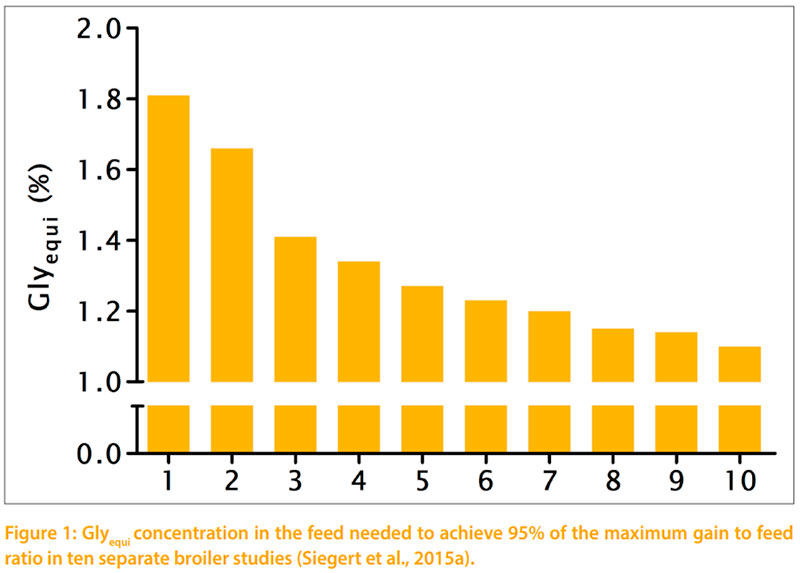
Growth response to Glyequi
Several dose-response studies investigating the effect of Glyequi in feed were published. A compilation of some studies shows that the growth response to incremental dietary Glyequi was inconsistent (Figure 1). This indicates that the response to Glyequi is influenced by other dietary factors.The metabolic formation of cysteine from methionine dissipates Glyequi (Figure 2a) (Powell et al., 2011). This is especially important in low crude protein feed because a targeted methionine+cysteine concentration usually is achieved by adding DLmethionine or analogue supplements, whereas free cysteine usually is not added. The meta-analysis by Siegert et al. (2015a) showed that the cysteine concentration in the feed has a substantial impact on the gain to feed (G:F) response to Glyequi even though the methionine+cysteine concentration did not vary considerably (Figure3). Fulflling the requirement of broiler chickens for both methionine and cysteine reduces the necessity to convert methionine to cysteine and, therefore, reduces the requirement for Glyequi. Glycine and serine are nonessential amino acids and, therefore, can be produced to some extent by the metabolism of the birds. Several substances can be metabolized to glycine or serine out of which threonine and choline are the quantitatively most important (Meléndez-Hevia et al., 2009). Threonine can be metabolized directly to glycine (Figure 2b), and choline can be metabolized to glycine with betaine and dimethylglycine as intermediate steps (Figure 2c). The study of Siegert et al. (2015b) showed that the response to Glyequi depended considerably on the threonine concentration in the feed (Figure 4). An increase in the threonine concentration reduced the Glyequi concentration required to achieve certain response levels. The same study also revealed that the choline concentration influenced the response to Glyequi and threonine. Therefore, concentrations of Glyequi, threonine, and choline need to be considered together in feed formulation. The observed potential of reducing the Glyequi concentration in feed by increasing the threonine and choline concentrations exceeded the theoretically possible replacement that can be explained by endogenous conversion processes. In consequence, the results shown in Figure 4 do not allow for the conclusion that adding threonine above recommendations prevents comprehensively from undesirable effects initiated by Glyequi defciency. Reasons for that are currently unknown and should be investigated before recommendations are made that can be applied by feed formulators.
There are further possible but scarcely investigated influencing factors on the response to dietary Glyequi. One of them is arginine which, together with glycine, is a precursor of guanidino acetic acid. Guanidino acetic acid then reacts to form creatine (Figure 2d), a compound that is involved in the energy supply of animal cells including the muscles. Interaction effects for guanidino acetic acid and arginine on the growth were reported for broiler chickens in several studies (e.g. Dilger et al., 2013). However, little is known about the effect of Glyequi on the growth response to arginine and guanidine acetic acid in the feed.
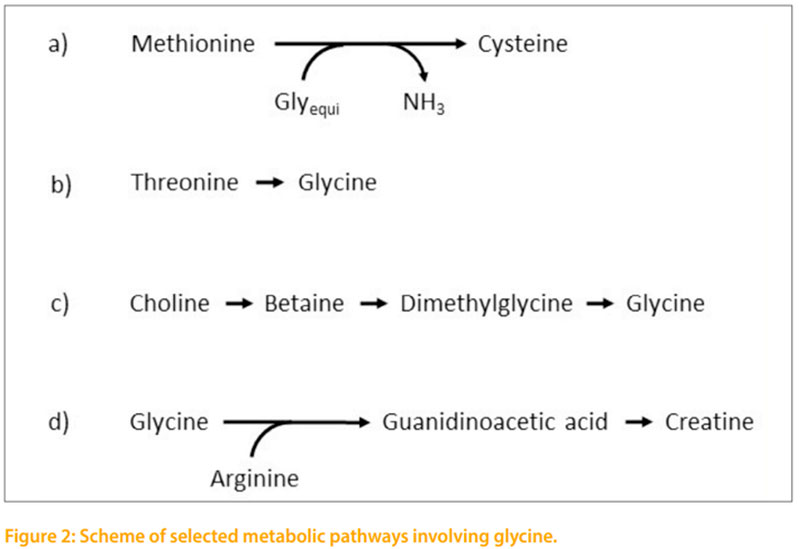

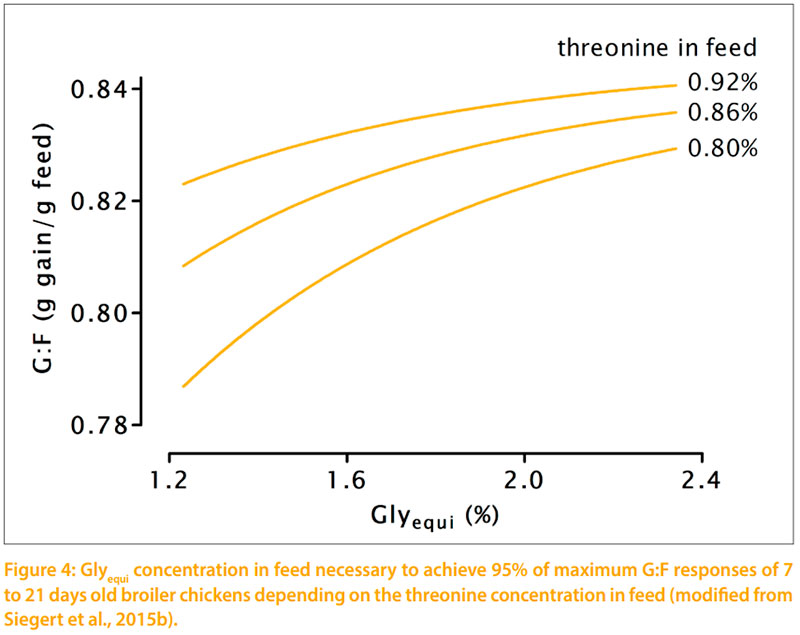
Glyequi concentration in feedstuffs
The concentration of Glyequi varies considerably between and within types of feedstuffs (Table 1). However, the variation in the Glyequi concentration of the protein is low. It ranges in most cereals, cereal byproducts, brewery byproducts, oil seeds, and pulses between 7.3 and 8.3 g/100 g crude protein. Compared to vegetable feedstuffs, the variation of the ratio of Glyequi to crude protein is higher in animal byproducts. While it is low in fsh meal, the ratio is very high in meat meal and particularly in meat and bone meal.Because the Glyequi concentration in vegetable proteins is low, using only vegetable ingredients in feed formulation restricts the possibility to increase or decrease the ratio of Glyequi in crude protein of plantbased feed. In consequence, formulating feed with Glyequi concentrations that avoid undesirable effects on the growth using plant-based feedstuffs only leads to an excessive supply of the animals with other amino acids. This can be avoided by feeding animal-derived proteins to poultry but those are prohibited in some countries. Feed additives suitable for elevating the Glyequi concentration in feed are free glycine and L-serine, which are not approved in some countries at this time.
In countries where animal-derived proteins are prohibited and free glycine and L-serine are not approved, an adequate Glyequi supply can only be achieved by a surplus supply with crude protein. Environmental and possible downsides need to be accepted if this strategy is pursued. A defcient Glyequi supply in low crude protein feed might be reduced by a surplus supply of endogenous precursors like threonine and choline. Betaine and dimethylglycine as intermediate steps when glycine is formed from choline might also be suitable endogenous precursors. However, these possibilities need to better investigated before the relevance of endogenous precursors of Glyequi in Glyequi-defcient feed can be better evaluated. Current status and perspectives of crude protein reduction
During the past decades the crude protein concentrations have been lowered basically because of knowledge of the requirements for essential amino acids. This enabled diminishing safety margins of crude protein supply but still ensured an adequate supply of essential amino acids. Current research continues to search for ways to reduce the crude protein concentration in feed without compromising growth (e.g. Corzo et al., 2005; Dean et al.,2006). Currently common crude protein concentrations in feed for broiler chickens from 1 to 21 days are about 21 to 22% (Figure 5). Dean et al. (2006) summarized that the growth of broiler chickens fed with feed containing less than 19 to 20% crude protein was reduced even when the requirement for essential amino acids was met. Considering additionally Glyequi enables to reduce the crude protein concentration in the feed considerably without undesirable effects on the growth. Several studies showed that the growth of broiler chickens from 1 to 21 days fed with feed containing 16% crude protein was at the level of feed with more than 20% crude protein if the Glyequi concentration was adequate (Figure 5) (Corzo et al., 2004; Dean et al., 2006; Siegert et al., 2015a).
Factors influencing the response to Glyequi such as those mentioned before were suboptimal in most published dose-response studies with Glyequi. Optimizing both the Glyequi concentration in the feed and the factors influencing the response to Glyequi should enable to reduce the crude protein concentration in the feed even further. The level to which the crude protein concentration in the feed with optimized concentrations of Glyequi and of the factors influencing the response to Glyequi has not been identifed so far.
Glycine and serine are the frst nonessential amino acids of which experimentally verifed requirement values are available. To our knowledge, experimentally verifed requirement values for other nonessential amino acids than glycine and serine are not available. It can be expected that the crude protein concentration in the feed can be reduced below 16% without adverse effects on the performance when the role of other nonessential amino acids needs is better understood and experimentally verifed requirement values are available.
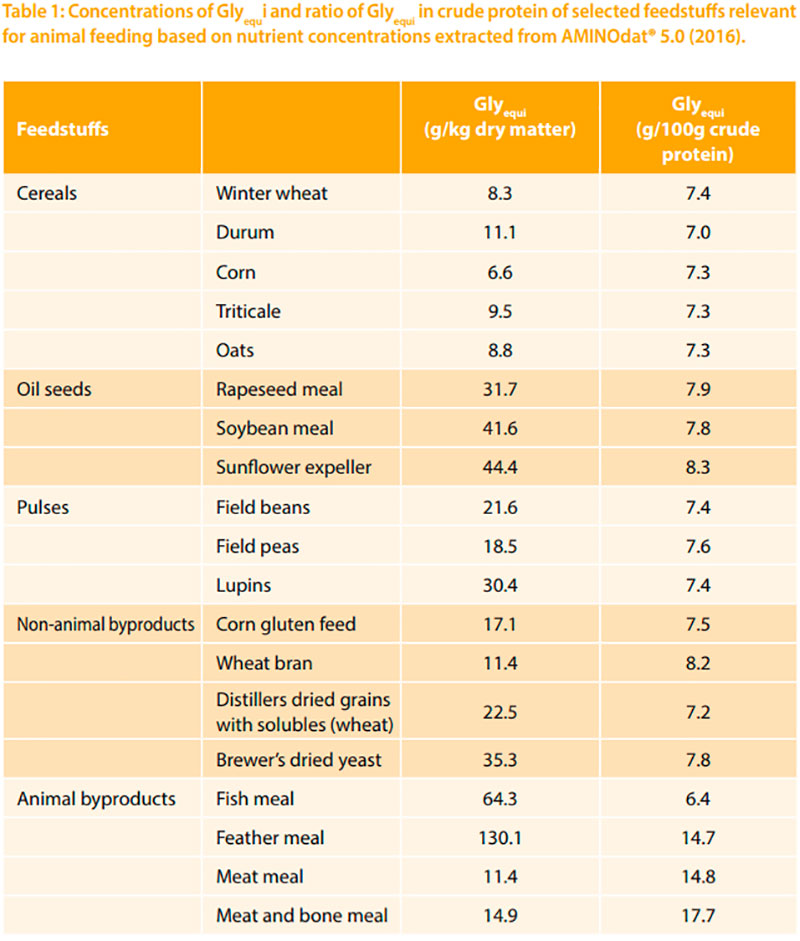
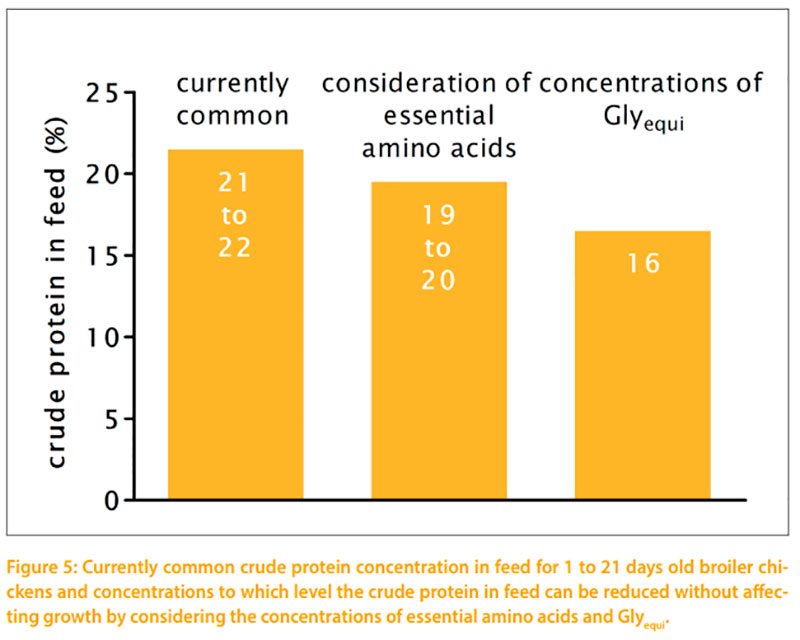
Conclusions
Glyequi usually is growth-limiting when the crude protein concentration in feed for broiler chickens from 1 to 21 days is below 19%. Considering of the concentration of Glyequi in feed enables to reduce the crude protein concentration in for broiler chickens to about 16%. The requirement for Glyequi depends on the concentrations of other nutrients in feed like threonine, choline, and cysteine. It can be expected on the long term that the crude protein concentration in feed for broiler chickens can be reduced below 16% without adverse effects on the growth when the requirement of other non essential amino acids is assessed.

References
Aftab, U., M. Ashraf, and Z. Jiang. 2006. Lowprotein diets for broilers World’s Poult. Sci.
J. 62:688-701.
AMINOdat® 5.0. 2016. PlatinumVersion,
Evonik Degussa GmbH, Health & Nutrition,
Hanau-Wolfgang, Germany.
Awad, E.A., I. Zulkifli, A.F. Soleimani. and T.C.
Loh. 2015. Individual non-essential amino
acids fortifcation of a low-protein diet for
broilers under the hot and humid tropical
climate. Poult. Sci. 94:2772-2777.
Christensen, K.D., Zimmermann, N.G., Wyatt, C.L., Goodman, T.N., Buhr, R.J., and Twining, P. 1994. Dietary and environmentalfactors affecting skin strength in broilerchickens. Poult. Sci. 73:224-235.
Corzo, A., C.A. Fritts, M.T. Kidd, and B.J. Kerr.
2005. Response of broiler chicks to essential and non-essential amino acid supplementation of low crude protein diets.
Anim. Feed Sci. Tech. 118:319-327.
Dean, D.W., T.D. Bidner, and L.L. Southern.
2006. Glycine supplementation to low
crude protein, amino acid-supplemented
diets supports optimal performance of
broiler chicks. Poult. Sci. 85:288-296.
Dilger, R. N., K. Bryant-Angeloni, R. L. Payne,
A. Lemme and C. M. Parsons. 2013. Dietary
guanidino acetic acid is an efcacious replacement for arginine for young chicks.
Poult. Sci. 92:171-177.
Jiang, Q., P.W. Waldroup, and C.A. Fritts.
2005. Improving the utilization of diets low
in crude protein for broiler chicken. 1. Evaluation of special amino acid supplementation to diets low in crude protein. Int. J.
Poult. Sci. 4:115-122.
Meléndez-Hevia, E., De Paz-Lugo, P., Cornish- Bowden, A., and Cárdenas, M.L. 2009.
A weak link in metabolism: The metabolic
capacity for glycine biosynthesis does not
satisfy the need for collagen synthesis. J. Biosci. 34:853-872.
Namroud, N.F., M. Shivazad, and M. Zaghari. 2008. Effects of fortifying low crude protein diet with crystalline amino acids on
performance, blood ammonia level, and
excreta characteristics of broiler chicks.
Poult. Sci. 87:2250-2258.
Namroud, N.F., M. Shivazad, and M. Zaghari. 2010. Impact of dietary crude protein
and amino acids status on performance
and some excreta characteristics of broiler
chicks during 10–28 days of age. J. Anim.
Physiol. An. N. 94:280-286.
Ospina-Rojas, I.C., A.E. Murakami, C. Eyng,
R.V. Nunes, C.R.A. Duarte, and M.D. Vargas.
2012. Commercially available amino acid
supplementation of low-protein diets for
broiler chickens with different ratios of
digestible glycine+serine:lysine. Poult. Sci.
91:3148-3155.
Ospina-Rojas, I.C., A.E. Murakami, C.R.A. Duarte, C. Eyng, C.A.L. Oliveira, and V. Janairo.
2014. Valine, isoleucine, arginine and glycine supplementation of low-protein diets
for broiler chickens during the starter and
grower phases. Br. Poult. Sci. 55:766-773.
Ospina-Rojas, I.C., A.E. Murakami, I. Moreira,
K.P. Picoli, R.J.B. Rodrigueiro, and A.C. Furlan. 2013: Dietary glycine+serine responses of male broilers given low-protein diets
with different concentrations of threonine.
Br. Poult. Sci. 54, 486-493.
Powell, S., Bidner, T.D., and Southern, L.L.
2011. Effects of glycine supplementation
at varying levels of methionine and cystine on the growth performance of broilers
fed reduced crude protein diets. Poult. Sci.
90:1023-1027.
Robel, E.J. 1977. A feather abnormality in
chicks fed diets defcient in certain amino
acids. Poult. Sci. 56:1968-1971.
Si, J., C.A. Fritts, D.J. Burnham, and P.W.
Waldroup. 2004. Extent to which crude
protein may be reduced in corn-soybean
meal broiler diets though amino acid supplementation. Int. J. Poult.
Sci. 3:46-50.
Siegert, W., H. Ahmadi, A. Helmbrecht, and
M. Rodehutscord. 2015b. A quantitative
study of the interactive effects of glycine
and serine with threonine and choline on
growth performance in broilers. Poult. Sci.
94:1557-1568.
Siegert, W., H. Ahmadi, and M. Rodehutscord. 2015a. Meta-analysis of the influence
of dietary glycine and serine, with consideration of methionine and cysteine, on
growth and feed conversion of broilers.
Poult. Sci. 94:1853-1863.
Sugahara, M., and M. Kandatsu. 1976. Glycine serine interconversion in the rooster.
Agric. Biol. Chem. 40, 833-837.
Thornton, S. A., A. Corzo, G. T. Pharr, W. A.
Dozier III, D. M. Miles, and M. T. Kidd. 2006.
Valine requirements for immune and
growth responses in broilers from 3 to 6
weeks of age. Br. Poult. Sci. 47:190-199.
Waguespack, A. M., S. Powell, T. D. Bidner,
and L. L. Southern. 2009. The glycine plus
serine requirement of broiler chicks fed
low-crude protein, corn-soybean meal
diets. J. Appl. Poult. Res. 18:761-765.







